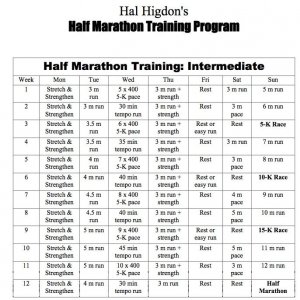A Guide to Finding the Right Workout Plan

Choosing a workout or training plan can be challenging. As a runner, there are many different schools of thought. Some people are in the Just Freaking Run (JFR) school of thought. These individuals don’t necessarily see the value of cross-training, weights, yoga, etc. They typically see themselves as runners. Period.
There are also people who strive for fitness balance. These people tend to look at the big picture and realize that strength training can help improve speed, prevent injury, and build a stronger overall athlete. Or, they realize that flexibility can help a runner avoid injury. Other runners who use a variety of types of training religiously practice yoga.

Defining Your Goals
What are your goals? To get bigger? Stronger? Faster? As a runner, my goal is usually to run further or faster. If my only objective is to build mileage, it seems pretty straightforward how to do that: run further. There are, however, rules on how to get there. Conventional wisdom states that a runner should only increase mileage by about 10% per week. This helps to prevent injury.
Runners working on speed would find that strength training often complements increasing speed. Incorporating core workouts to improve core strength is helpful in running.
Many runners find that cardio lifting is the best choice, rather than heavy lifting. This is often achieved through circuit training involving hand weights, bands, kettlebells and other items you can use in your home.
Once you have set goals and identified what is important to you as an athlete, you can move forward.
Setting a Timeline
There are multiple considerations for timeline. First, how long do you have to achieve your goal? For example, are you training for a half-marathon in four months? If so, you need to find a training plan that allows you to go from your current level of fitness to where you want to be in four months.
Next, you need to consider how much time you have on an average daily and weekly basis for training. I immediately cut one training plan off my “consideration list” because it implemented a mid-week longer run. I knew this would not fit into my life.
When I create my training schedule I look for something with a weekend-long run, 3-4 other runs, with a time obligation of 35-55 minutes for everything other than the long run. For summer training, I never want to run over 6 miles because I detest running in hot weather. These are considerations I keep in mind.
Researching Plans
There are many running-related training programs out there, and many coaching schools of thought. Couch to 5K, Hal Higdon, Cool Running, Nike Running App; all of these is viable choices. However, if you are starting to run with zero base fitness the below Hal Higdon plan probably is an unreasonable choice for you, a beginner program would be a better choice.

Often a new runner will come to me and say, “I want to run a marathon!”
When I inquire “when?” sometimes the answer is way, way too soon given the person’s current level of fitness. I recently advised a young woman that perhaps she should start with a 5K. Some people might call me discouraging, but I don’t see it that way.
If the end goal is a marathon keep that insight! But better to start with a smaller, easier to obtain goal than to start with a 26.1 goal and struggle to get there.

Tweaking a Plan to Suit Your Needs
Unless you’re training for the Olympics, it’s okay to modify your plan. No, I did not give you permission to skip your long run every week; however, it IS okay to look at the plan and make it fit your life. For example, I almost always complete my long run on Saturdays.
For my first few years of serious running, however, I ran long on Sundays. Why? Because Monday nights I had a cycling spin class and this was a great way to recover from a long run. I “tweaked” my plan to allow for this (long run Sundays, non-impact cross-training Mondays).
Other Considerations
Weather: If I am a runner living in Wisconsin, training for a May marathon, I will be training in cold weather. I may want to purchase a treadmill, or get a gym membership, or load up on cold weather running gear. Things I need to train in below zero temps: running hat, running gloves, wind jacket, headlamp for night running (because it feels like it’s always dark during the winter here), reflective gear, among other things.

Other obligations: If you have a weekly Thursday night obligation, maybe that should be a rest day. Or if you go into work late every Wednesday, speedwork would be a good fit for Wednesday mornings.
Types of Training You Wish to Implement: Some athletes love lifting, and want to weight lift 3-4 days each week. If that is you, you might want a training plan that only involves running 3 days each week. (Yes, you can run a great race on only 3 or 4 days of running each week. Emphasize quality over quantity.)
Staying on Track
It is important to stay focused in order to find success within a training program. I find putting my training plan on paper is helpful. Some people like their training plan to be entirely online. When I started running, I struggled with knowing how far I was running. I would jump in my car and figure out the distance of the loop I planned to run.
Now, I know that smart watches such as the Garmin, Apple Watch, Suunto, etc. exist to make this easier.
There are apps that track mileage run, mileage on particular pairs of shoes, training plans, and other important things.
Just Do It!
Once you have chosen a workout plan that fits your needs, tweaked it if necessary, and decided how you will track your workouts, you are ready to move forward. The easy part is done. It’s time to do the work and crush your goals.
Latest Articles
 Is Running on a Treadmill Easier Than Running Outside?Runners have their own preferences, whether it is treadmill running, running outside on the road, or exploring trails. So...
Is Running on a Treadmill Easier Than Running Outside?Runners have their own preferences, whether it is treadmill running, running outside on the road, or exploring trails. So... Is It OK to Use Trail Running Shoes on the Road?While trail running shoes can be used on roads, especially in situations where a runner encounters mixed terrains or pref...
Is It OK to Use Trail Running Shoes on the Road?While trail running shoes can be used on roads, especially in situations where a runner encounters mixed terrains or pref... How to Fix Sore Quads After Running?Rest, ice, gentle stretching, and over-the-counter pain relievers can help soothe sore quads after running. Also, ensure ...
How to Fix Sore Quads After Running?Rest, ice, gentle stretching, and over-the-counter pain relievers can help soothe sore quads after running. Also, ensure ... 10 Fruits With The Most Electrolytes to Replace Sports DrinksThese fruits are high in electrolytes such as potassium, magnesium, and calcium, essential for hydration, muscle function...
10 Fruits With The Most Electrolytes to Replace Sports DrinksThese fruits are high in electrolytes such as potassium, magnesium, and calcium, essential for hydration, muscle function...

